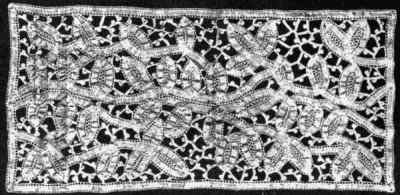Transcriber's Note:
A number of typographical errors have been corrected. They areshown in the text with mouse-hover popups.
Beginning at page 22, all images have been provided as thumbnails. A largerversion of those images is available by clicking on the image number.
THE ART
OF
MODERN LACE-MAKING.
PRICE:
FIFTY CENTS OR TWO SHILLINGS.
PUBLISHED BY
The Butterick Publishing Co. (Limited).
London and New York.
1891
PRINTED IN NEW YORK.

INTRODUCTION.
Owing to the growing popularity of the fascinating art of lace-makingand the appeals of our readers to place it within their reach, we haveprepared this pamphlet. In making it a perfect instructor and a reliableexponent of the favorite varieties of lace, we have spared neither timenor expense, and are most happy to offer to our patrons what acelebrated maker of Modern Lace has pronounced as "the finest book uponlace-making to be found on either continent."
The illustrations, in the main, are direct reproductions from genuine,hand-made modern laces, such as any lady may make who masters theinstructions found upon these pages.
The beauty of these laces is beyond question, their durability all thatcan be desired, and their textures may be varied from an extremedelicacy to a sumptuous opposite. In introducing the art of modernlace-making into the realms of our readers, we feel all of the pleasurewe are sure we thus convey.
The Butterick Publishing Co.,
Limited.
CONTENTS.
Pages 5 to 9—
Lace-Making, Ancient and Modern Methods.
Pages 9 to 19—
Stitches used in Modern Lace-Making.
Pages 19 to 22—
Fancy Braids Cords, Rings and Buttons.
Pages 22 to 96—
Designs, Lace Articles, Edgings, etc., etc., in Modern Lace.
Pages 96 to 125—
Darned Net Samples, Kerchiefs, Tidies, Edgings, Insertions, etc.,
etc., with Designs for the same and other Articles.
Lace-Making[Pg 5]
ANCIENT AND MODERN METHODS.

The art of making lace in one form or another has existed from theearliest ages. There are Scriptural references to various web-likefabrics, which were of rude construction, no doubt, but whose generalcharacteristics were identical with those productions of modern skillwhich have for centuries been known as lace. Homer and other ancientwriters constantly mention net-works of fancifully embroideredmaterials; gold thread-work was known to the Romans; and as Egyptianrobes of state are depicted upon the tombs of the earlier dynasties asbeing fashioned from a looped net-work or crochet, it is probab